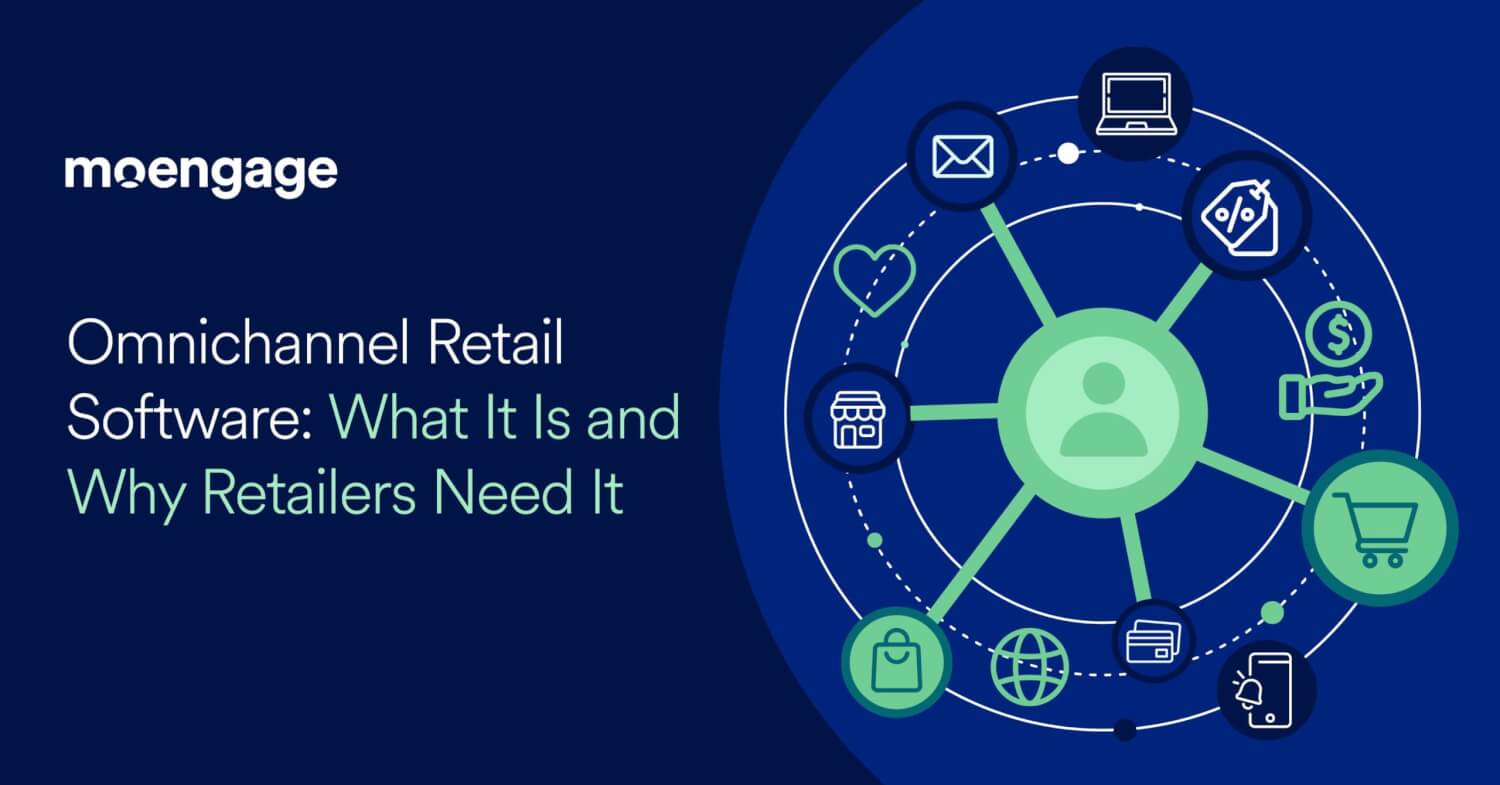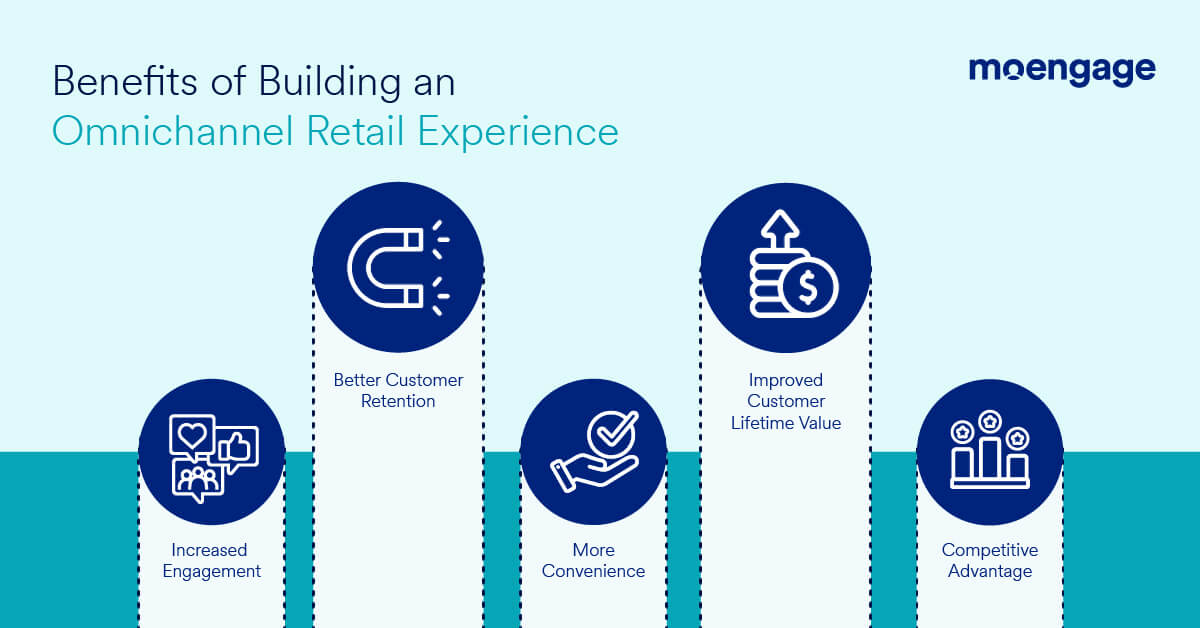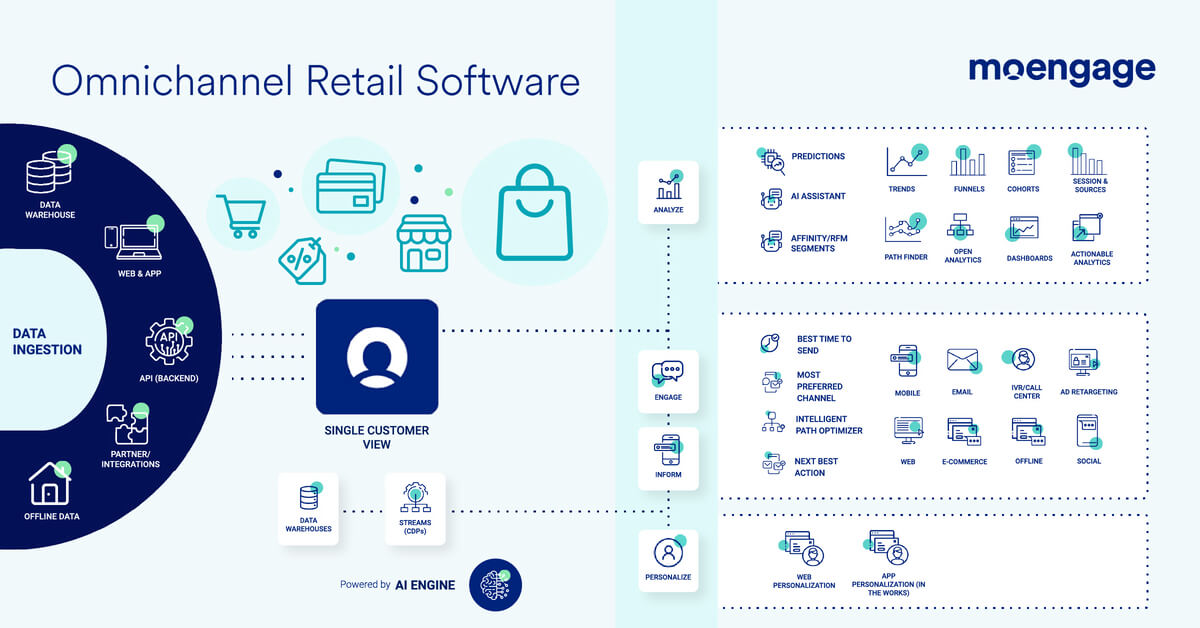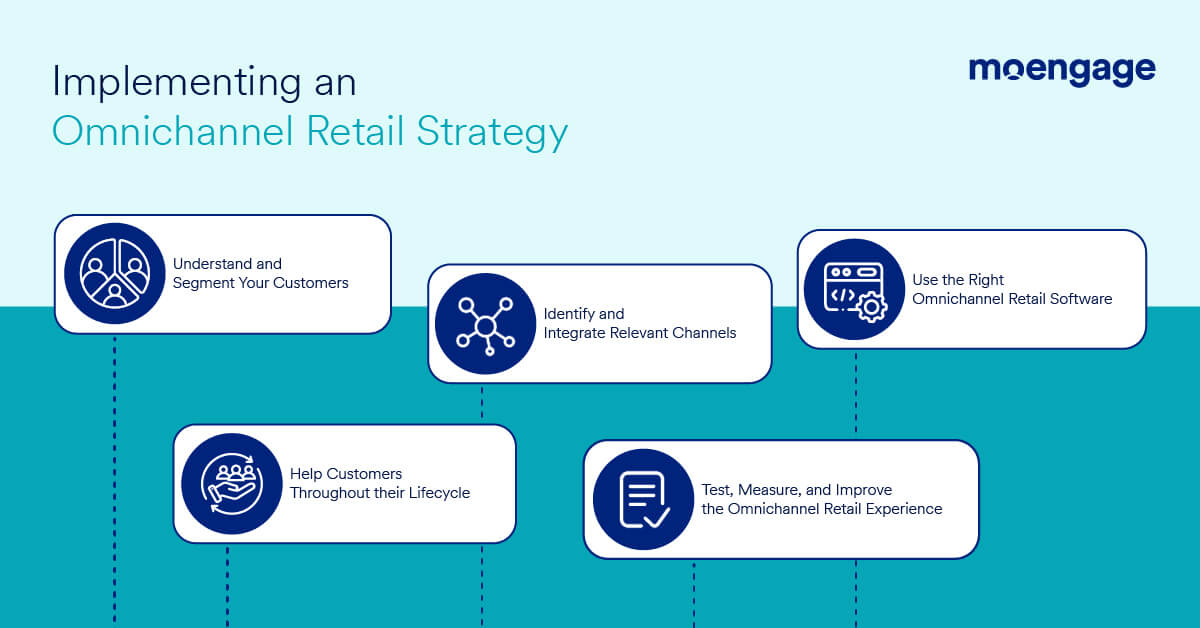Omnichannel Retail Software: What It Is and Why Retailers Need It

Reading Time: 9 minutes
The retail industry has evolved tremendously in the last few years, with brands incorporating more channels to be closer to their customers. However, to truly provide shoppers with a seamless and personalized experience, retail brands need an omnichannel retail software in their martech stack.
Why? An Omnichannel retail software connects all the offline and online channels like physical stores, mobile apps, social media platforms, and websites to offer customers a smooth shopping experience. It unifies customer data from various sources into a single platform, gives retailers the ability to have real-time access to customer data, and helps them personalize experience across all channels.
In this blog, we’ll dig deeper into what omnichannel in retail is, why it is essential, and how omnichannel retail software can play a role in it.
We’ll walk you through:
- What Is Omnichannel in Retail
- Five Benefits of an Omnichannel Retail Experience
- Omnichannel Retail Software Evaluation Criteria: How to Choose One
- Best Omnichannel Retail Solution: Key Features
- Omnichannel Retail Solution Implementation Strategy
- Providing the Best Omnichannel Retail Experience to Your Customers With MoEngage
This will help you understand the significance of omnichannel strategies in the retail industry and the need for an omnichannel retail platform to deliver seamless customer experiences.
What Is Omnichannel in Retail?
Omnichannel in retail is a strategy that marketers use to integrate all their offline and online channels to create a seamless experience for their shoppers. It allows customers to shop from anywhere – local stores, brand websites, mobile apps, or even social media – while getting a consistent and engaging experience, regardless of the channel.
According to a report by McKinsey, 60%–70% of consumers engage in omnichannel shopping. Furthermore, a study quoted in the Harvard Business Review indicates that customers who use more than four channels spend 9% more in the store than those who use a single channel. These statistics re-emphasize that omnichannel in retail is the need of the hour.
Five Benefits of an Omnichannel Retail Experience
While it is common to mistake omnichannel marketing for multichannel marketing, they are two different things. A multichannel retail experience is based on multiple channels which are operated in silos. On the other hand, an omnichannel retail experience is based on converging various communication channels so that shoppers receive continued interactions at every touchpoint.

Here are some ways you can benefit from the omnichannel approach:
1. Increased engagement
Retail stores benefit from human interactions. You can communicate with your customers directly and guide them through their buying journey. This brings a personal touch and makes the shopping experience engaging for them.
Omnichannel retail strategies augment this experience. This is because it gives you access to unified customer data on a single omnichannel retail software, from which you can extract insights to engage your customers successfully.
Here’s an example. Let’s assume a customer left an abandoned product in their cart while shopping on your app. You can create an omnichannel flow that sends them an email with a limited-time offer on the product, followed by a push notification to re-target and nudge them to complete their purchase.
2. Better customer retention
Customers get frustrated when retailers don’t understand their preferences and bombard them with irrelevant messages. Not addressing this issue can lead to customer churn.
On the other hand, omnichannel marketing helps you understand the finer nuances of customer preferences and behavior, allowing you to make all your interactions with them relevant.
For example, if a certain customer engages more with your push notifications, you can leverage that as your primary communication channel. Or, if a customer typically browses your app at a certain hour of the night, you can schedule an in-app notification at that time. Or, if a customer has a history of shopping for a certain product from you, you can inform them when there is an offer on that product.
3. More convenience
According to a DoorDash survey on how consumers shop online, 74% of the respondents put convenience as their top priority while shopping for consumables.
Omnichannel marketing provides customers with convenience and flexibility when shopping. For example, a customer can click on an email link while sitting at home, add an item to a shopping cart, and pick up their online order directly from the nearest store!
4. Improved customer lifetime value (CLV)
Since omnichannel marketing provides a comprehensive customer view, retailers have visibility into each customer’s browsing history and purchase behavior. This helps them to identify opportunities for upselling and cross-selling products via tailored recommendations that can be sent through the preferred channel(s) of the respected customer.
Hyper-personalized recommendations nudge customers to purchase those products, leading to repeat purchases and greater CLV and revenue.
Let’s assume you have a customer who interacts heavily with your emails and regularly purchases electronic items from your app; you can send him an email with product recommendations of the ‘top 5 most-bought electronic accessories on your app’, with links that allow him to add the items to their cart.
5. Competitive advantage
With the increase in the number of brands in the retail ecosystem, having some form of differentiation is the key to standing out. Customers like to feel heard and valued. So, you need to ditch the good old spray-and-pray communication and build a seamless and tailored customer journey.
With an omnichannel retail strategy, you can integrate all customer touchpoints, monitor the customer’s journey, and send them contextually relevant messages at the right time. A consistently personalized and well-integrated experience will prompt customers to choose your brand over your competitors.
Omnichannel Retail Software Evaluation Criteria: How to Choose One
We’ve identified the numerous benefits of using omnichannel in the retail industry. However, you need a robust omnichannel retail software to make an omnichannel strategy scalable. Such a platform is essential to connect all the channels, allow smooth data exchange, and provide a seamless and personalized customer experience.

You’ll find multiple omnichannel retail software options that promise to build an omnichannel customer experience.
But here are a few parameters you must check while trying to find the right omnichannel retail software for your needs:
1. Comprehensive customer view
The biggest challenge for a retailer is gathering customer data from disparate sources and building a complete profile. You can provide a connected experience to customers if you have all the details about their behavior patterns and buying choices with you. A good omnichannel retail solution will get you all these details in one place. It will save you the headache of switching between different platforms to build a unified customer profile.
Find an omnichannel retail software that seamlessly integrates online and offline channels to provide a comprehensive customer view.
For example, MoEngage’s Customer Engagement Platform unifies in-app, in-store, and online data to create a 360-degree view of the customer. It gives you a complete insight into their behavior patterns, identifies friction in customer journeys, and helps you develop hyper-personalized campaigns to win customers.
2. Integration
Seamless integration with third-party apps is necessary to improve customer engagement and conversions, automate campaigns, and other purposes.
Choose an omnichannel retail solution that allows seamless and secure integration with other third-party apps and point solutions.
MoEngage, for example, has carefully built a network of 160+ partners. You can choose any of these partners and natively integrate the MoEngage platform with their apps to share data and insights and deliver highly relevant content and experience to customers.
| Check the MoEngage® Catalyst Partner Ecosystem to discover and integrate your favorite apps with the MoEngage platform. |
3. Hyper-personalization
According to our Personalization Pulse Check report, 32% of North American customers say they will switch to an alternative if the brand they purchase from sends them communication unrelated to their shopping behavior. Clearly, hyper-personalization is no longer just a buzzword.
Ensure that your omnichannel retail software hyper-personalizes customer experiences and brand communication based on customers’ online and in-store interactions with your brand, preferred categories, and past purchases. This will help you reduce cart abandonment and churn risk and keep your customers engaged always.
MoEngage, the ultimate omnichannel marketing platform for retail brands, provides advanced segmentation and personalization capabilities that enable you to understand the collective persona deeply and deploy personalized and segmented campaigns for cart abandonment, product recommendations, price alerts, etc. The platform can help you achieve 4x higher engagement.
4. AI-driven capabilities
Understanding customers’ desires and communicating with them requires nuance. There’s no room for guesswork.
Select an omnichannel retail software that uses Artificial Intelligence (AI) capabilities to eliminate all the guesswork, understand the customer, and send them the right message at the right time.
MoEngage’s AI-powered Sherpa does precisely that. It takes the guesswork out of the omnichannel strategy and helps you create experiences that customers love – right from the first interaction. It can send contextually relevant messages at the right time across preferred channels and maximize engagement.
5. Automation
Creating a seamless and consistent journey across all touchpoints can be challenging if you do it manually. There are also chances of errors creeping in; not to forget the time and resources needed to set it up manually. Automation can save you time and deploy omnichannel campaigns at scale.
When looking for omnichannel retail software, ensure it provides automation capabilities. This will help you automate customer journeys at all stages, build 1:1 customer relationships, and scale up your marketing efforts.
A platform like MoEngage can automate strategies and deliver personalized customer experiences at all stages. You can also leverage our ready-to-implement engagement workflows to automate campaigns and encourage customers to download apps, drive in-app purchases, and reduce cart abandonments.
| Learn more about creating a perfect omnichannel journey in our eBook, Retail Marketing Guide: The Brick-to-Click Omnichannel Experience. Download the E-book |
Best Omnichannel Retail Solution: Key Features
MoEngage’s Omnichannel Marketing Platform is one of the best solutions for retailers to build a cohesive customer experience. It provides all the features mentioned above. Here’s how you can benefit from using this platform:
| Omnichannel Retail Software Needs | MoEngage Feature | How This Helps |
| Comprehensive Customer View | MoEngage’s omnichannel retail solution can unify customer data and insights in one place. | Understand your customers better, deploy customer-centric targeted campaigns and drive results. |
| Integration | MoEngage’s app marketplace allows you to discover and integrate your preferred apps natively with MoEngage. | Seamlessly share data and insights between integrated apps. Harness them at the right moment to deliver personalized experiences to customers across different channels. |
| Hyper-personalization | MoEngage’s Omnichannel Marketing Platform provides advanced segmentation and personalization capabilities. | Understand customers deeply and deploy highly targeted campaigns for cart abandonment, product recommendations, price alerts, etc. |
| AI-driven capabilities | MoEngage’s AI-powered Sherpa eliminates the guesswork of the omnichannel strategy. | Create experiences that customers love – right from the first interaction. Send contextually relevant messages at the right time across preferred channels, while increasing engagement by 4x. |
| Automation | MoEngage’s platform enables marketers to automate customer journeys across all touchpoints. | Experiment with different customer flows, enabling you to find the right one for each customer. Execute automated marketing campaigns aligned with the customer journey. |
Omnichannel Retail Solution Implementation Strategy
While omnichannel retail solutions allow you to unify customer data, analyze, and provide a frictionless experience across all touchpoints, you also need an implementation strategy to make this approach successful.

1. Understand and segment your customers
To begin, gain a comprehensive understanding of your customers’ demographics, preferences, and typical behavior. Utilize this knowledge to categorize your customers into various segments, such as high-value customers and those at risk of churning. You can develop tailored campaigns to engage each segment effectively by doing so.
| Learn how to build successful omnichannel campaigns in our blog, Omnichannel Retail Marketing (Part 3): Mastering Campaigns. |
2. Identify and integrate the channels your customers use the most
The critical difference of the omnichannel retail strategy is reaching customers where they are present. That’s why once you know your customers, identify the channels they use the most and align it with the customer’s journey. Make every touchpoint shoppable and offer a personalized and consistent experience across all of them. This will help you increase conversions and sales.
3. Use the right omnichannel retail software
Integrating different channels and ensuring smooth data flow is complex, especially when physical and digital channels are involved. That’s why you need the right all-in-one omnichannel retail software that integrates all channels, unifies data from various sources, automates processes, and delivers a smooth customer experience.
Compare all the available omnichannel retail platforms thoroughly and select the one that will help you provide a smooth customer experience across all channels.
MoEngage’s platform ticks all those boxes. You can unify all the channels, orchestrate multiple campaigns from one place, and automate campaigns to send personalized messages to the right person at the right time. It saves you time and effort in planning and deploying campaigns.
4. Help customers throughout their lifecycle
An inconsistent experience can frustrate customers and lead to churn. Ensure your customer support team is trained to offer consistent guidance to customers across different touchpoints. For this, they must have access to the customer data. This will help them to not only understand the customer better but also personalize their experience.
Take Value City, for example. This furniture retail brand wanted to solve a common problem that most customers face while shopping online – seeing the furniture in real. Value City solved this problem using omnichannel digital marketing. They built an ‘Easy Platform’ that allowed customers to create a shopping list online and visit nearby stores. The sales clerk could view the list and show the furniture to the customer.
| You can read more about successful retail case studies to know how omnichannel retail solutions can help you engage your customers throughout their lifecycle. |
5. Test, measure, and improve the omnichannel retail experience
Continuous testing and monitoring are necessary to improve the omnichannel experience. Test everything – from workflows to messaging. Leverage all the available data to find the potential flaws in omnichannel campaigns and solve them. This will help you enhance the customer experience further and deepen your relationship with them.
Provide the Best Omnichannel Retail Experience to Your Customers With MoEngage
In a nutshell, adopting an omnichannel approach that integrates all your communication channels is essential for your retail brand. This will help you increase repeat purchases, maximize profits, and retain customers. That’s why you need to invest in the right omnichannel retail software.
MoEngage’s Omnichannel Marketing Platform is built with AI-powered Sherpa. They provide advanced segmentation and personalization capabilities that help companies collect customer data across all channels, analyze them, and create high-conversion omnichannel campaigns.
Request a demo to convert your window shoppers into loyal customers and see your revenue grow.









